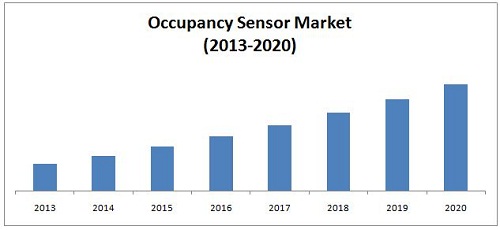Occupancy sensors detect occupancy at a location and turns on light signals. These are automatic lighting control devices that use various technologies including ultrasonic, infrared and microwave. Growing awareness about energy saving is influencing innovation in the sensor technology used in smart lighting and illumination. Mounting occupancy sensors reduces a great deal of electricity consumption of the building. Strong rise in demand from around the world is the major driver for the global occupancy sensor market. The industry is expected to maintain impressive growth with increased adoption of this technology around the world. Boon in the smart housing and smart lighting market is also expected to create vital business opportunities for the key players in this market during the next few years to come.
Major Market Drivers & Restraints
According to the experts the occupancy lighting market is steadily driven by four major drivers. These drivers include increasing demand for the energy efficient devices across offices as well as residential areas. Development of efficient and the most accurate devices is also creating rise in the rate of adoption in the market. Favorable government policies and trends of energy saving are also expected to drive the industry during the next few years. Advancements in the HVAC market in terms of programmable and configurable devices are also expected to create steady rise in demand in this industry. Major restraining factors for the market include incompatibility with the existing systems and wireless network systems, false triggering of the switches and time out period of energy savings. Despite these factors; the market is expecting steady growth with implementation of IPOS and intelligent sensors.
Segmentation and Forecasting Reports
Experts segment the global occupancy sensor market into different types of technologies, which include ultrasonic, passive infrared and dual technology that includes both ultrasound and infrared. Several other technologies used in the market include image processing occupancy sensors (IPOS) microwave and intelligent occupancy sensors (IOS). The network connectivity segments in the market include Wi-Fi, Z-Wave, ZigBee, and EnOcean. Basic applications of these sensors range across education, governmental, offices, retail, hospitality, residential, healthcare, and other end-user applications. The geographic regions of the market include North America, Asia Pacific, Europe and rest of the world. The rest of the world region includes elaborate analysis of the regions including Latin America, Middle East and Africa.
According to the latest reports, the occupancy sensor market is expected to be driven at a CAGR of over 18%, from 2014 to 2020. At the projected growth rate, it is expected to become worth more than $4.67 billion by the end of the year 2020. North America is expected to occupy more than 40% of the overall market share, while Asia Pacific region is expected to be the fastest growing geographic region in the global market.



